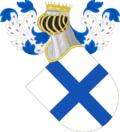Berengaria of Portugal
| Berengaria of Portugal | |
|---|---|
 Reconstructed face of Queen Berengaria | |
| Queen consort of Denmark | |
| Tenure | 1214–1221 |
| Born | 1191 or 14 December 1194 |
| Died | 27 March 1221 (aged 26–31) Ringsted, Denmark |
| Burial | |
| Spouse | Valdemar II of Denmark |
| Issue | Eric IV of Denmark Sophia, Margravine of Brandenburg Abel of Denmark Christopher I of Denmark |
| House | Burgundy |
| Father | Sancho I of Portugal |
| Mother | Dulce of Aragon |
| Religion | Roman Catholicism |
Berengaria of Portugal (Portuguese: Berengária; Portuguese pronunciation: [bɨɾẽˈɡaɾiɐ]) (Danish: Bengjerd) (1190s–27 March 1221), was a Portuguese infanta, later Queen consort of Denmark. She was the fifth daughter of Portuguese King Sancho I and Dulce of Aragon. She married Danish King Valdemar II and was the mother of Danish kings Eric IV, Abel and Christopher I.
Background
Berengaria was the tenth of eleven children born to her parents. By the age of seventeen in 1212, Berengaria was an orphan; her father died in 1212, while her mother had died in 1198. In various annals and ballads she is called Bringenilæ, Bengerd, Bengjerd and related forms.
Marriage
Berengaria was introduced to King Valdemar through his sister, Ingeborg, the wife of King Philip II of France, another of her cousins; she was by that time at the French court, having left Portugal with her brother Ferrante in 1211.
Within seven years of marriage, the couple had four surviving children:
- Eric IV of Denmark (1216–1250), King of the Danes (1241–1250)
- Sophie (1217–1247), married John I, Margrave of Brandenburg, had issue
- Abel of Denmark (1218–1252), King of the Danes (1250–1252)
- Christopher I of Denmark (1219–1259), King of the Danes (1252–1259)
Old folk ballads says that on her deathbed, Dagmar of Bohemia, Valdemar's first wife, begged the king to marry Kirsten, the daughter of Karl von Rise and not the "beautiful flower" Berengaria. In other words she predicted Berengaria's sons' fight over the throne would bring trouble to Denmark, although this is merely legend and there is no historical proof of this.
Queen
Valdemar’s first wife, Dagmar of Bohemia, had been immensely popular, blonde and with Nordic looks. Queen Berengaria was the opposite, described as a dark-eyed, raven haired beauty.
The Danes made up folk songs about Berengaria and blamed her for the high taxes Valdemar levied, although the taxes went to his war efforts, not just to his Queen. The great popularity of the former queen made it difficult for the new queen to gain popularity in Denmark as queen. She is noted to have made donations to churches and convents. Berengaria was the first Danish queen known to have worn a crown, which is mentioned in the inventory of her possessions (1225).
In 1221 Berengaria, after giving birth to three future kings, died in childbirth. Queen Berengaria is buried in St. Bendt's Church in Ringsted, Denmark, on one side of Valdemar II, with Queen Dagmar buried on the other side of the King.
Legacy

Valdemar's two queens play a prominent role in Danish ballads and myths - Dagmar as the soft, pious and popular ideal wife and Berengaria (Bengjerd) as the beautiful and haughty woman.[1]
When queen Berengaria's grave was opened in 1885, they found her thick plait of hair, her finely formed skull and finely built body bones, proving the legends about her reported beauty. A portrait (see above) drawing was made to show how she might have looked.
Ancestry
| Family of Berengaria of Portugal | ||||||||||||||||||||||||||||||||||||||||||||||||||||||||||||||||||||||||||||||||||||||||||||||||||||||||||||||||||||||||||||||||||||||||||||||||||||||||||||||||||||||||||||||||||||||||||||||||||||||||||||||||||||||||||||||||||||||||||||||||||||||||||||||||||||||||||||||||||||||||||||||||||||||||||||||||||||||||||||||||||||||||||||||||||||||||||||||||||||||||||||||||||||||||||||||||||||||||||||||||||||||||||||||||||||||||||||||||||||||||||||||||||||||||||||||||||||||||||||||||||||||||||||||||||||||||||||||||||||||||||||||||||||||||||||||||||||||||||||||||||||||||||||||||||||||||||||||||
|---|---|---|---|---|---|---|---|---|---|---|---|---|---|---|---|---|---|---|---|---|---|---|---|---|---|---|---|---|---|---|---|---|---|---|---|---|---|---|---|---|---|---|---|---|---|---|---|---|---|---|---|---|---|---|---|---|---|---|---|---|---|---|---|---|---|---|---|---|---|---|---|---|---|---|---|---|---|---|---|---|---|---|---|---|---|---|---|---|---|---|---|---|---|---|---|---|---|---|---|---|---|---|---|---|---|---|---|---|---|---|---|---|---|---|---|---|---|---|---|---|---|---|---|---|---|---|---|---|---|---|---|---|---|---|---|---|---|---|---|---|---|---|---|---|---|---|---|---|---|---|---|---|---|---|---|---|---|---|---|---|---|---|---|---|---|---|---|---|---|---|---|---|---|---|---|---|---|---|---|---|---|---|---|---|---|---|---|---|---|---|---|---|---|---|---|---|---|---|---|---|---|---|---|---|---|---|---|---|---|---|---|---|---|---|---|---|---|---|---|---|---|---|---|---|---|---|---|---|---|---|---|---|---|---|---|---|---|---|---|---|---|---|---|---|---|---|---|---|---|---|---|---|---|---|---|---|---|---|---|---|---|---|---|---|---|---|---|---|---|---|---|---|---|---|---|---|---|---|---|---|---|---|---|---|---|---|---|---|---|---|---|---|---|---|---|---|---|---|---|---|---|---|---|---|---|---|---|---|---|---|---|---|---|---|---|---|---|---|---|---|---|---|---|---|---|---|---|---|---|---|---|---|---|---|---|---|---|---|---|---|---|---|---|---|---|---|---|---|---|---|---|---|---|---|---|---|---|---|---|---|---|---|---|---|---|---|---|---|---|---|---|---|---|---|---|---|---|---|---|---|---|---|---|---|---|---|---|---|---|---|---|---|---|---|---|---|---|---|---|---|---|---|---|---|---|---|---|---|---|---|---|---|---|---|---|---|---|---|---|---|---|---|---|---|---|---|---|---|---|---|---|---|---|---|---|---|---|---|---|---|---|---|---|---|---|---|---|---|---|---|---|---|---|---|---|---|---|---|---|---|---|---|---|---|---|---|---|---|---|---|---|---|---|---|---|---|---|---|---|---|---|---|---|---|---|---|---|---|---|---|---|---|---|---|---|---|---|---|---|---|---|---|---|---|---|---|---|---|---|---|---|---|---|---|---|---|---|---|---|---|---|---|---|---|---|---|---|---|---|---|---|---|---|---|---|---|---|---|---|---|---|---|---|---|---|---|---|---|---|---|---|---|---|---|---|---|---|---|---|---|---|---|---|---|---|---|---|---|---|---|---|---|---|---|---|---|---|---|---|---|---|---|---|---|---|---|---|---|---|---|---|---|
| ||||||||||||||||||||||||||||||||||||||||||||||||||||||||||||||||||||||||||||||||||||||||||||||||||||||||||||||||||||||||||||||||||||||||||||||||||||||||||||||||||||||||||||||||||||||||||||||||||||||||||||||||||||||||||||||||||||||||||||||||||||||||||||||||||||||||||||||||||||||||||||||||||||||||||||||||||||||||||||||||||||||||||||||||||||||||||||||||||||||||||||||||||||||||||||||||||||||||||||||||||||||||||||||||||||||||||||||||||||||||||||||||||||||||||||||||||||||||||||||||||||||||||||||||||||||||||||||||||||||||||||||||||||||||||||||||||||||||||||||||||||||||||||||||||||||||||||||||
References
External links
![]() Media related to Berengaria of Portugal at Wikimedia Commons
Media related to Berengaria of Portugal at Wikimedia Commons

